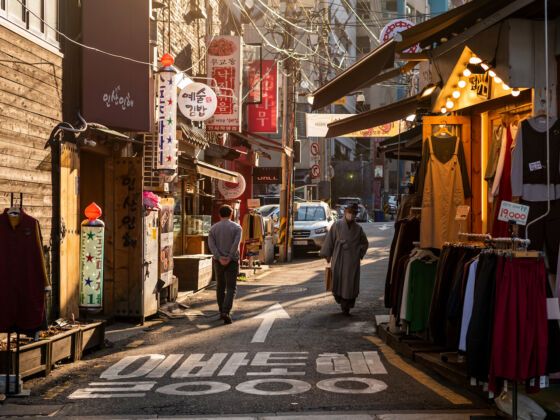In Busan, South Korea, I head to dinner near Jagalchi Fish Market, the city’s famous seafront area. During the day, the neighborhood is filled with middle aged women sporting short permed hair, rubber dishwashing gloves, rain boots, waders, and sharp knives, skinning and gutting seafood by the moundful. Block after block of stalls showcase creatures from the ocean swimming in tanks, laid out on ice, and piled carelessly on the sidewalk.


The specialty in the neighborhood’s restaurants is hoetjip, Korean-style sashimi. Like most meals in Korea, hoetjip is accompanied by a dozen or more small side dishes, called panchan. Inevitably, the panchan will include plates of the ubiquitous sweet and sour pickled radish, fiery kimchi, spicy gochujang sauce, and sliced raw garlic to add even more potentcy. There are also piles of lettuce greens and shiso leaves for wrapping around bites of meat.
I enthusiastically start in on some of the more familiar panchan like fried seafood pancake, steamed prawns in the shell, and sauteed squid. A cluster of side dishes causes my chopsticks to pause midair. I don’t recognize any of the food, but that’s not what stops me. Part of appreciating food is presentation and on these plates, presentation fails. The chunks of whatever sea creature these are are so downright ugly no garnish could improve the scene.
One plate holds a pile of sea pineapple or sea squirt (meongge), beautiful when alive, with yellow fading into to red across it’s spiky spherical shell like a tropical sunset. Shelled, its butter-colored flesh has a complex flavor combining sour, fruity, and briny, with a dominant off-putting metallic taste that doesn’t merit repeating.
Next, I pluck up a piece of what I later learn is the regrettably named sea penis (gaebul). The name is also unfortunately accurate: when alive, the creature looks like a dismembered, pneumatically-propelled alien phallus. The shape also reminds me of sausage making; at the moment the filling is pushed into the stretchy casing. Dead – for the meat is dead, I poke it to make sure – the sea penis is deflated and small, looking like a flayed worm, shiny and pink like a tongue. Its crunchy and chewy texture is surprisingly pleasant.
My chopsticks finally aim towards the last untried morsels, a substance that can be generously described as resembling chunks of slug. Its glossy, soft flesh is a mottled mix of khaki green, deep brown, mustard yellow, and blue-gray, combined to make a surface both artful and repulsive.
If I saw this beast in my kitchen at home, I’d wonder how it had oozed its way inside from the backyard. But, I’m determined to try anything once, especially if it’s already on the table in front of me. With a deep breath and a deeper sigh, I pick up one of the smaller chunks.
And it moves.
More specifically it contracts, tightening up and getting smaller, tenser, and harder. I instantly drop the meat, snatch back my chopsticks, and wait to see if it will do anything else, like scream. A few seconds later, the glutenous blob relaxes, returning to a more puddle-like, flaccid state.
Being prone to occasional acts of immaturity, I begin to poke the different pieces on the plate, making each piece repeatedly contract and relax. If I do this enough, maybe the creatures will die or creep away. In my gut, I’m hoping for the latter. No such luck however, the blobs stay put.
I’m convinced these are pieces of a recently sliced up larger creature, its nerves firing in an unconscious parody of life, no different than a recently beheaded chicken running around a farmyard There’s no one to ask. None of the staff speak English, and the only other customers in the restaurant are a large party of raucously drunk Korean businessmen.
Once again, I grab a piece of mystery seafood. It predictably tenses up as I drag it through the gochujang sauce, which could make shoe leather taste phenomenal. I pop the piece into my mouth and try to chew, except the creature’s flesh is unyielding to my teeth.
I surreptitiously extract the misbehaving nosh from my mouth. As I stare down the difficult remains of food, I devise a new strategy. After I put another piece in my mouth, I leave it on my tongue, waiting for it to relax, just like it did on the plate.
As I feel the tension leaving the morsel, I attack quickly and chew remorselessly. There’s the brief flavor of ocean before I swallow my first living creature. Afterward, all I can think is, “Where’s my soju?”